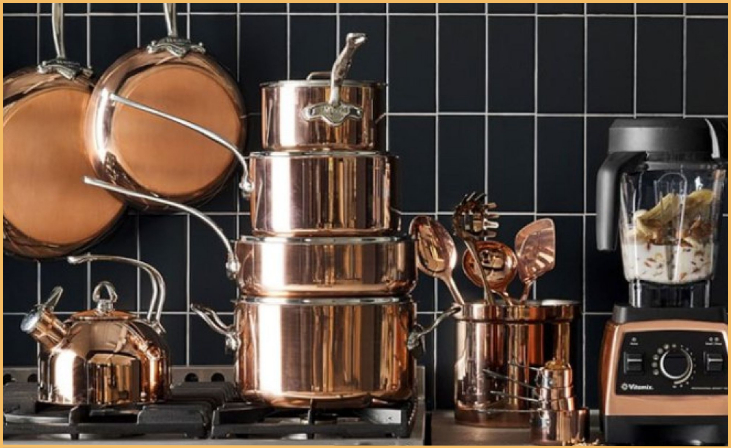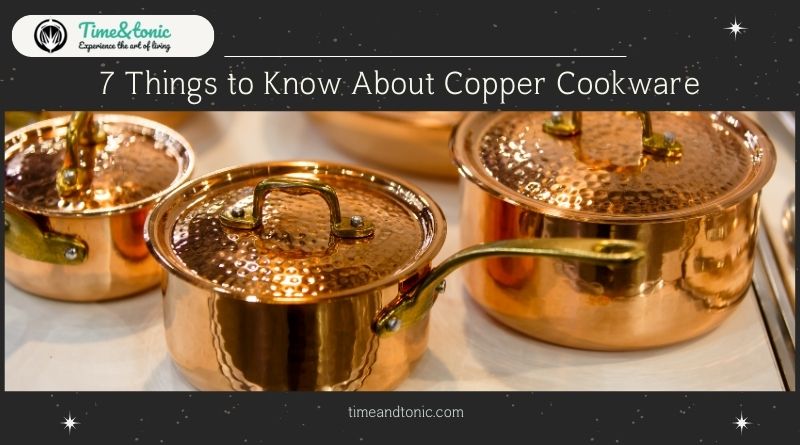7 Things To Know About Copper Cookware
Copper cookware has long been cherished by chefs and home cooks alike for its exceptional heat conductivity and elegant appearance. If you’re considering investing in copper cookware or have recently acquired a set, there are several important things you should know to make the most of this kitchen essential. From understanding the maintenance requirements to the benefits of cooking with copper, this blog post will provide you with valuable insights into this timeless culinary tool. In this article, we’ll explore the advantages and maintenance requirements of copper cookware, helping you make an informed decision about its place in your kitchen.
Excellent Heat Conduction

Copper cookware is renowned for its excellent heat conduction properties. In the culinary world, copper has long been prized for its ability to evenly distribute heat across the cooking surface. This superior heat conductivity means that your food cooks more uniformly, reducing the risk of hot spots that can lead to unevenly cooked dishes.
Copper pots and pans are highly responsive to changes in temperature, allowing for precise control over your cooking. When you adjust the heat source, copper cookware responds almost immediately, giving chefs the ability to fine-tune cooking techniques with ease.
Additionally, copper’s rapid heat distribution makes it an ideal choice for delicate dishes that require precise temperature control, such as sauces and candies. It’s also great for tasks like searing meat to achieve perfect caramelization.
However, it’s important to note that copper cookware typically has a lining of stainless steel or tin to prevent any chemical reactions with certain foods. Proper maintenance is essential to keep copper cookware in top condition, including regular polishing to maintain its lustrous appearance.
Efficient Heat Distribution
Copper cookware is highly regarded for its efficient heat distribution capabilities. This characteristic makes it a favorite among culinary enthusiasts and professional chefs. Copper’s outstanding heat conductivity ensures that heat is evenly spread across the entire cooking surface, eliminating hot spots that can lead to unevenly cooked food.
The even distribution of heat in copper cookware allows for precise control over cooking temperatures. Whether you’re simmering a delicate sauce or searing a steak, copper responds quickly to adjustments in heat levels, providing cooks with exceptional control over their culinary creations.
Furthermore, copper’s responsiveness to changes in temperature is particularly advantageous for tasks that require immediate adjustments, such as sautéing or flipping delicate ingredients. This responsiveness translates into improved cooking outcomes and more consistent results.
It’s worth noting that copper cookware often features a lining of stainless steel or tin to prevent any chemical reactions with certain foods, ensuring that your dishes not only cook perfectly but also taste their best.
Quick Link: 7 Best Wedding Tips for Beautiful Brides of 2023
Responsive to Temperature Changes
Copper cookware is prized for its remarkable responsiveness to temperature changes. This quality sets it apart as a top choice for chefs and cooking enthusiasts alike. Copper’s ability to rapidly and uniformly adjust to shifts in heat levels makes it an invaluable tool in the kitchen.
When you turn up or down the heat source, copper cookware responds almost instantly. This characteristic allows for precise control over cooking processes. Whether you’re searing meats, sautéing vegetables, or simmering delicate sauces, copper cookware provides a level of control that is unmatched.
This responsiveness is particularly advantageous for tasks that demand quick adjustments, such as flipping ingredients or adjusting the intensity of a simmer. It ensures that your food is cooked to perfection, achieving the desired texture and flavor.
However, it’s essential to note that most copper cookware features a lining, often made of stainless steel or tin, to prevent any chemical reactions with certain foods. This lining ensures that your culinary creations not only benefit from precise temperature control but also maintain their flavor and quality.
Retains Heat Well
Copper cookware is renowned for its exceptional heat retention properties. This quality makes it a preferred choice for both professional chefs and home cooks. Copper’s ability to retain heat effectively allows for precise and consistent cooking.
When copper cookware is heated, it not only quickly distributes heat across its surface but also retains that heat for an extended period. This characteristic is especially valuable when searing, braising, or slow-cooking dishes. The steady and even heat provided by copper ensures that food cooks uniformly and retains its flavors and moisture.
Copper’s heat retention is particularly advantageous for tasks that require maintaining a steady temperature over time. This includes simmering sauces, reducing liquids, or keeping dishes warm until serving. The result is dishes that are not only beautifully cooked but also taste exquisite.
It’s important to note that copper cookware often features a lining, commonly made of stainless steel or tin, to prevent any chemical reactions with specific foods. This lining ensures that your culinary creations benefit from copper’s heat retention without compromising taste or safety.
Requires Regular Maintenance

Copper cookware, while prized for its excellent heat conductivity and responsiveness, demands regular maintenance to keep it in top condition. Copper has a tendency to tarnish and react with certain foods, necessitating care and attention from its users.
To maintain the stunning appearance of copper cookware, regular polishing is essential. Over time, copper develops a patina, which some find charming, but if you prefer the bright, shiny look, frequent polishing with a copper cleaner or a mixture of salt and vinegar can restore its luster.
Additionally, most copper cookware features a lining made of materials like stainless steel or tin to prevent any adverse reactions with acidic foods. These linings can wear down over time and may require periodic replacement, depending on usage.
Another aspect of maintenance involves avoiding abrasive cleaning tools and harsh detergents, which can damage the lining or the copper itself. Instead, opt for gentle cleaning methods like a soft sponge or cloth with mild dish soap.
Reacts with Certain Foods
Copper cookware, though prized for its superb heat conductivity, is known to react with certain foods, which is an important consideration for users. Copper can react with acidic or alkaline foods, potentially causing unwanted chemical interactions that affect both the taste and safety of the dishes.
Acidic ingredients like tomatoes, vinegar, and citrus fruits can react with copper, leaching small amounts of copper into the food. While copper is an essential trace mineral, excessive consumption can be harmful, leading to health concerns. To mitigate this, most copper cookware includes a lining made of materials like stainless steel or tin to create a barrier between the copper and the food.
However, it’s crucial to inspect the lining regularly for signs of wear or damage, as it can deteriorate over time. If you notice any signs of degradation, consider having the lining professionally replaced.
Prone to Scratches and Dents
To prevent scratches, it’s advisable to use wooden or silicone utensils when cooking in copper pots and pans. These materials are less likely to cause abrasions that can mar the copper’s surface.
Dents can occur if the cookware is dropped or bumped against hard surfaces. While dents are typically cosmetic and do not affect the cookware’s functionality, they can be less visually appealing. Some people appreciate the character that dents can add to copper cookware, but if you prefer a pristine appearance, it’s essential to handle it with care.
Regularly inspect your copper cookware for any signs of damage, and address minor issues promptly to prevent them from worsening. While scratches and dents are a natural part of the aging process for copper cookware, they can be minimized with proper handling and care.
Final Words
In conclusion, copper cookware offers a blend of beauty and functionality that can elevate your culinary endeavors. With its exceptional heat conductivity and precise temperature control, it’s a favorite among professional chefs and passionate home cooks. However, caring for your copper cookware is essential to ensure its longevity and performance. Regularly polishing to maintain its shine and understanding the potential reactions with certain foods are key aspects of ownership.
Investing in quality copper cookware is an investment in your kitchen’s future, as these pieces can last a lifetime and even become family heirlooms. Whether you’re searing, sautéing, or simmering, the benefits of cooking with copper are undeniable. So, equip your kitchen with the timeless elegance and superior performance of copper cookware, and let your culinary creations shine.
FAQs
While copper is an excellent conductor of heat, it can react with acidic foods, potentially leading to a metallic taste. To mitigate this, copper cookware is often lined with a layer of stainless steel or tin, making it safe for cooking a wide range of dishes.
To maintain the luster of your copper cookware, regularly clean it with a mixture of salt and vinegar or lemon juice. Additionally, use a specialized copper cleaner to polish and remove tarnish. Avoid using abrasive scouring pads, as they can scratch the surface.
Copper cookware excels in tasks that require precise temperature control, such as making delicate sauces or caramelizing sugar. It’s also excellent for quickly heating and cooling, making it ideal for tasks like searing meats or reducing liquids.




